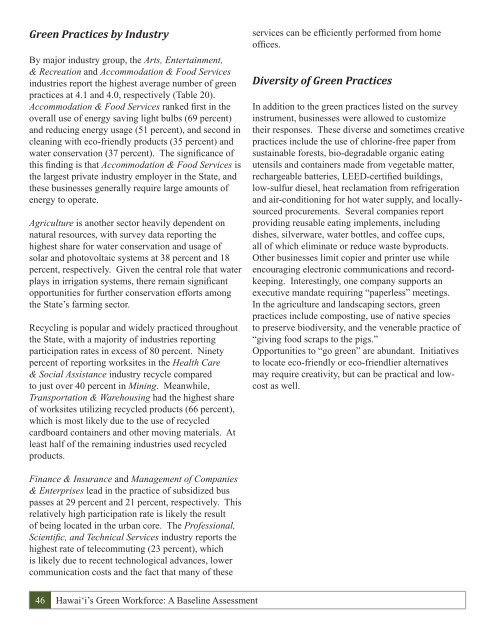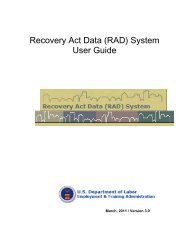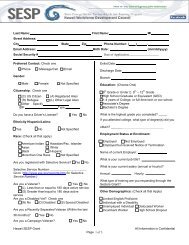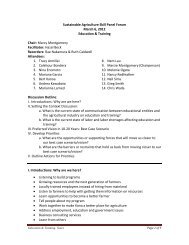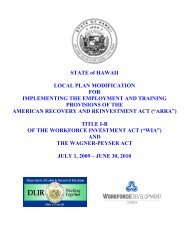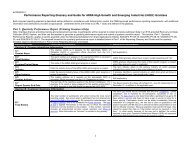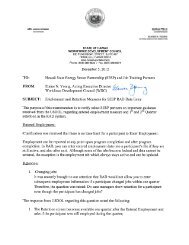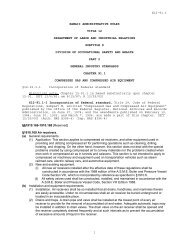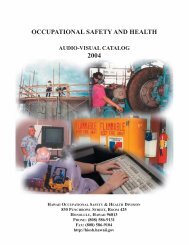Hawai i's Green Workforce A Baseline Assessment December 2010
Hawai i's Green Workforce A Baseline Assessment December 2010
Hawai i's Green Workforce A Baseline Assessment December 2010
You also want an ePaper? Increase the reach of your titles
YUMPU automatically turns print PDFs into web optimized ePapers that Google loves.
<strong>Green</strong> Practices by Industry<br />
By major industry group, the Arts, Entertainment,<br />
& Recreation and Accommodation & Food Services<br />
industries report the highest average number of green<br />
practices at 4.1 and 4.0, respectively (Table 20).<br />
Accommodation & Food Services ranked first in the<br />
overall use of energy saving light bulbs (69 percent)<br />
and reducing energy usage (51 percent), and second in<br />
cleaning with eco-friendly products (35 percent) and<br />
water conservation (37 percent). The significance of<br />
this finding is that Accommodation & Food Services is<br />
the largest private industry employer in the State, and<br />
these businesses generally require large amounts of<br />
energy to operate.<br />
Agriculture is another sector heavily dependent on<br />
natural resources, with survey data reporting the<br />
highest share for water conservation and usage of<br />
solar and photovoltaic systems at 38 percent and 18<br />
percent, respectively. Given the central role that water<br />
plays in irrigation systems, there remain significant<br />
opportunities for further conservation efforts among<br />
the State’s farming sector.<br />
Recycling is popular and widely practiced throughout<br />
the State, with a majority of industries reporting<br />
participation rates in excess of 80 percent. Ninety<br />
percent of reporting worksites in the Health Care<br />
& Social Assistance industry recycle compared<br />
to just over 40 percent in Mining. Meanwhile,<br />
Transportation & Warehousing had the highest share<br />
of worksites utilizing recycled products (66 percent),<br />
which is most likely due to the use of recycled<br />
cardboard containers and other moving materials. At<br />
least half of the remaining industries used recycled<br />
products.<br />
Finance & Insurance and Management of Companies<br />
& Enterprises lead in the practice of subsidized bus<br />
passes at 29 percent and 21 percent, respectively. This<br />
relatively high participation rate is likely the result<br />
of being located in the urban core. The Professional,<br />
Scientific, and Technical Services industry reports the<br />
highest rate of telecommuting (23 percent), which<br />
is likely due to recent technological advances, lower<br />
communication costs and the fact that many of these<br />
46 <strong>Hawai</strong>ÿi’s <strong>Green</strong> <strong>Workforce</strong>: A <strong>Baseline</strong> <strong>Assessment</strong><br />
services can be efficiently performed from home<br />
offices.<br />
Diversity of <strong>Green</strong> Practices<br />
In addition to the green practices listed on the survey<br />
instrument, businesses were allowed to customize<br />
their responses. These diverse and sometimes creative<br />
practices include the use of chlorine-free paper from<br />
sustainable forests, bio-degradable organic eating<br />
utensils and containers made from vegetable matter,<br />
rechargeable batteries, LEED-certified buildings,<br />
low-sulfur diesel, heat reclamation from refrigeration<br />
and air-conditioning for hot water supply, and locallysourced<br />
procurements. Several companies report<br />
providing reusable eating implements, including<br />
dishes, silverware, water bottles, and coffee cups,<br />
all of which eliminate or reduce waste byproducts.<br />
Other businesses limit copier and printer use while<br />
encouraging electronic communications and recordkeeping.<br />
Interestingly, one company supports an<br />
executive mandate requiring “paperless” meetings.<br />
In the agriculture and landscaping sectors, green<br />
practices include composting, use of native species<br />
to preserve biodiversity, and the venerable practice of<br />
“giving food scraps to the pigs.”<br />
Opportunities to “go green” are abundant. Initiatives<br />
to locate eco-friendly or eco-friendlier alternatives<br />
may require creativity, but can be practical and lowcost<br />
as well.


